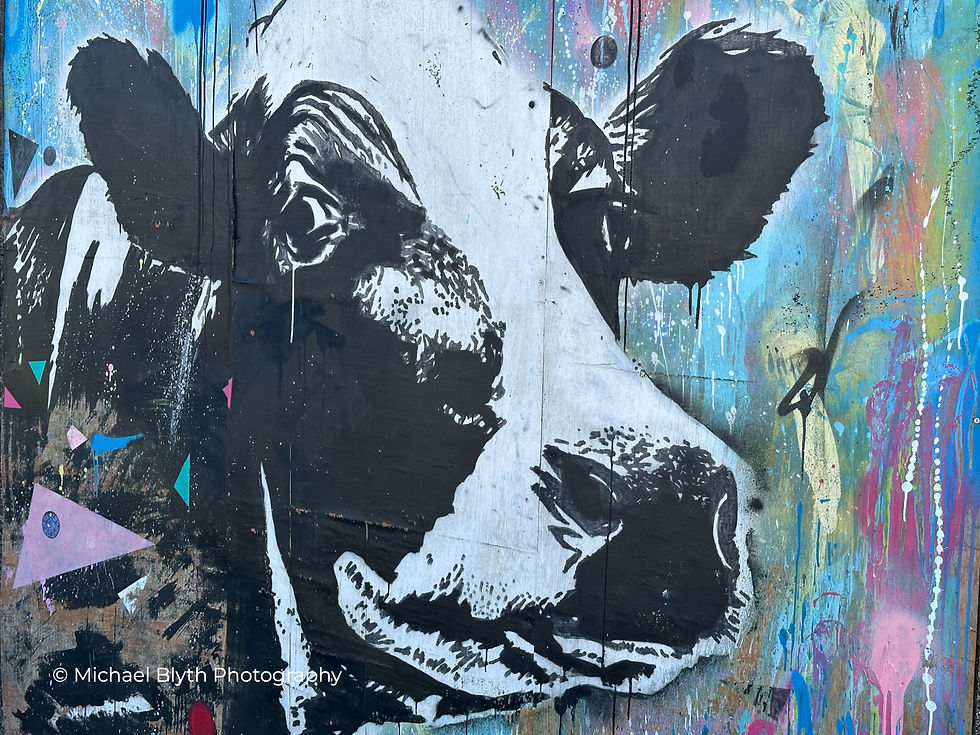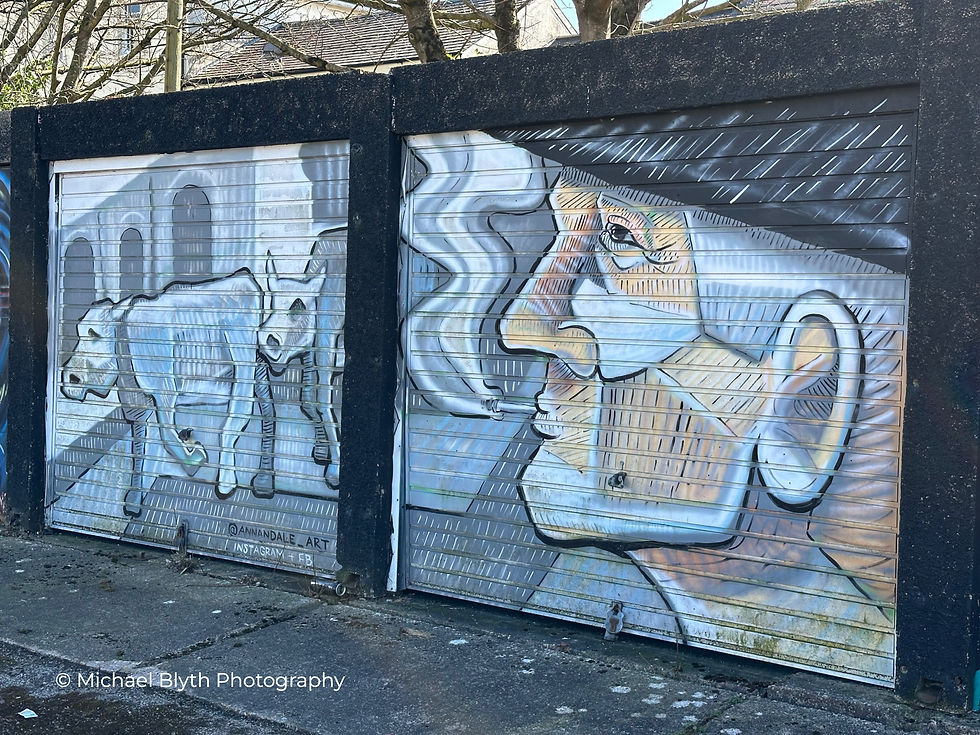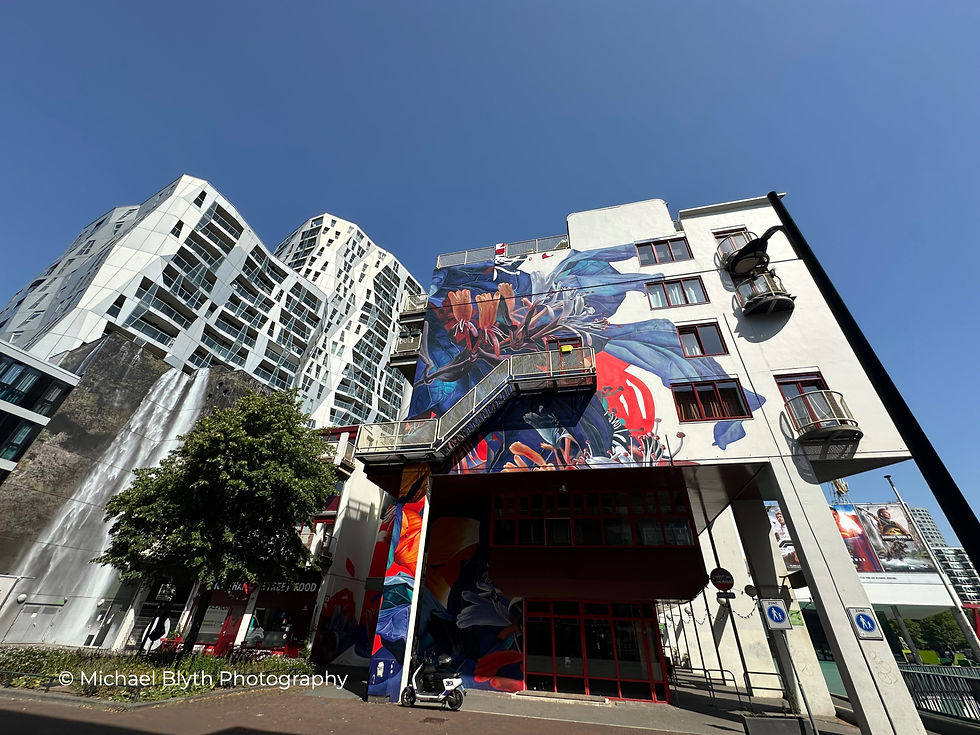Exploring Graffiti and Street Art Around the World – with Simple Photography Tips
- Michael Blyth

- Jul 16
- 5 min read
Five simple photography tips on what to do when you're stuck in a foreign city - street art and graffiti - Camera and Phone Camera
Consider the Whole Environment — Not Just the Art
Vary Your Angles to Add Character
Use Camera Height and Lines to Guide the Eye
Watch for Unwanted Reflections or Light Spill
Look for Local Personality and Emotion
So it's quite interesting to do a little research on graffiti, and it's definitions, which gives a better understanding of what I'm "chatting" about today..
A simple "what is the definition of graffiti" on the net, resulted in:
Drawings or inscriptions made on a wall or other surface, usually so as to be seen by the public.
A form of vandalism involving painting text or images in public places.
A form of art involving painting text or images in public places.
Any writings or drawings on a surface in a public place, placed there without authorisation of the owner of the object on which it is written. Such graffiti are usually unwelcome, and are considered as form of vandalism.
I'm not sure when in history someone started 'adorning' walls with writing or drawings, and I guess we will never know whether the art in caves that goes back to Neanderthal times would fit the above definitions as we don't know who owned the walls in the cave .... and all that!
What does fascinate me is the range of imagery, and there is an increasing fascination in the whole genre of street art, and the artists involved, both well-known such as: Jean-Michel Basquiat, Banksy, Keith Haring, Shepard Fairey, and Os Gemeos; and the unknown "urban art guerillas"
For me, there are features of graffiti that are unique to a region, not in a way I can necessarily explain, but nonetheless make them worth photographing.
In fact so much so that one of them saved the day, when I couldn't find a Valentine's day card that I thought my wife would like.
Let's have a look at these images and I'll stick in a few, hopefully helpful Simple Photography Tips for you. I've pulled together some graffiti, or street art from various parts of the world,

Images One and Two, from a disused railway station in the Netherlands, are a variation on the same work, with just a variation on what I allowed into the picture. Both are bright and vibrant, and probably are expressing something unknown to me.

I small mention is that both have grass growing in the bottom of the image, not something I normally include, but in this case it adds maybe to the street-art by suggesting back-street, unkept.

The third image, taken just along from the first two, illustrates how one image changes, different artist, but the left hand end shows the right hand text from the previous images. The whole wall a picture, but broken into individuality, with signatures on each piece.
I've no idea of how it was formed in terms of one night, or weeks.

Image Four, I found adorning a garage door. It is a wonderful piece of more conventional art, and a magnificent representation of that animal that is so important to society.
I love the purity of form, with the monochrome of the anilmal against a range of pastel shades. The vertical and horizontal joins of the planks composing the doors, opened up by the changing weather, add to the scene.
A simple photography tip here, and in several of the images is to take from off-centre, adding even more character to the image than a straight forward 'copy' would do.

Almost the same location as Image Four, this image of a multi-coloured sheep makes me chuckle, the look of shock making me wonder what it's seen. Others might assume it's something awful, for me, it's gob-smacked rather than fear.
Again I've taken from the side, and note, sometimes extraneous light and reflection can spoil the colour saturation if you don't.

The row of garages where I took these images, while waiting for my turn at the Passport Office at Newport in wales, were a fertile ground for varying styles of street-art.
Here I've stepped back to give some 'environment' or background to the scene. The black of the garages themselves frames the paintings, but separates them as well.
I'm intrigued by the 'signature' as the only reference to @annandale_art I can find is to someone on the Lake District.

Image Seven is a return to the Netherlands, with a fairly whacky scene. It's quite an appropriate place to put graffiti, and is not to my mind 'street-art' in the way the other images are. The vertical, and leaning construction of the walkway, with repeated wording on both sides, and brightly coloured, leads to the roundal on which re graffiti sits.
One simple photography technique to note here is the choice of height. I've chosen the camera height to allow the yellow boarding to form a line of cut-off from the tree and concrete behind. Focusing the eye on the foreground and then the graffiti.

Image seven, more or less the same place in this location of feverish artistic activity, makes great art, with line and from breaking lots of art-rules. The dramatic juxtaposition of angular form and curves, of red, black and yellow, and depth of field.
And notice the line of screws gently directing the eye from bottom left, where all is in focus, to middle right out of focus.

Image Eight was and is one of those scenes where whatever means of capturing an image, whether conventional film camera, DSLR or phone, and whatever lens, there are great scenes to capture.
This one, taken on my iphone 14 Pro, is using the ultra-wide angle, to include the wacky buildings, and to push the converging lines.
Use a telephoto and you'd be equally dramatic, just choose your spot - perhaps the honeysuckle at the top of the steps, perhaps the steps, with the shadow and flowers below.

Sometimes there is clear and informed decision behind the imagery on walls, as shown by Images Nine and Ten. In this case, to brighten up a boring passageway.
When taking these images, there was light from the end of the passage reflecting off the wall further down, spoiling the art.

In these cases a physics meets photography tip worth remembering is 'angle of incidence equals angle of reflection' meaning that light hitting a wall at say, twenty degrees, will reflect at twenty degrees in the opposite direction
A good rule renamed physics meets snooker!

Image Eleven, not the Valentines day image I used, but the same place, and the same artist Juliette B'art. It is so very cheerful, and besides my wife and daughter were in a queue for an ice-cream, so what better way to while away the time!
To be critical of my work, chopping off the very bottom of Juliette's signature. In my defence, I was trying to exclude too much of the next oart of the image from interfering in the bottom left.



Comments